The Bismarck tribune. [volume] (Bismarck, N.D.), 01 Dec. 1934.
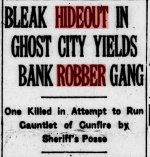
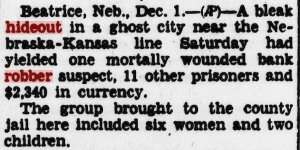
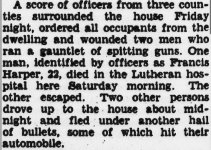
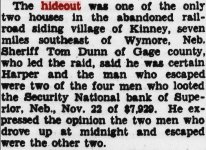
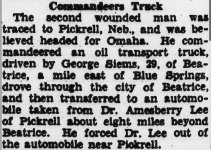
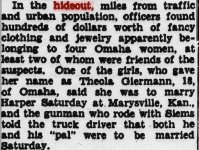
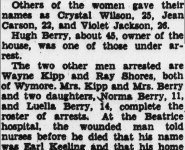

https://chroniclingamerica.loc.gov/...ext=&andtext=&dateFilterType=yearRange&page=1
Ghosts of the town of Kinney, Island Grove Township
Kinney, Gage County, Nebraska, was a town that was born of necessity and died in a hail of gunfire. Practically no trace of it now exists. Sumac and scrub box elder now overgrow the area where once a busy little town and a whistle stop on the Burlington Railroad flourished.
In the years from 1910 until the town breathed its last in the early 1930s, if you were to board the east bound local at Wymore, find yourself a seat and by the time you could have smoked a pipe of tobacco, you would find the train slowing down. If you looked out the window as the train pulled into the station you would read the name Kinney on the depot. You would see also a grain elevator a stock yard, a coal and lumber establishment and a large square front store building. Actually the store building was divided into 2 long rooms and part of the time was operated as two separate stores. The train would take on and unload passengers and load cream cans and cases of eggs. Then perhaps a car of cattle or hogs and a car of grain would be added to the train before it moved on. If you had a letter to mail you were directed to the store building where the store keeper also acted as postmaster. These stores sold anything from a pair of shoes to a wood burning stove. There were a few good frame houses in the town primarily occupied by people who ran the business there. A steep rocky winding road climbed the hill on the south of the town and a beautiful valley of wheat and corn fields was on the north. As you looked west the railroad soon curved south through the hills and out of sight as it followed Wolf creek on its way toward the Blue River.
These large limestone hills have acquired the name Kinney hill and like the town were named for the pioneer family named Kinney. Wild Cat Creek and Wolf Creek merge in the valley at the foot of these hills.
When this was a part of the Otoe Indian reservation, at an earlier time, there was a large Indian settlement on the hill about a mile north west of where the town was later to be built. It was near the largest of the many springs of clear cold water that can be found in this area. This spring ran even during the drought of the early 1930s. There is also a cemetery, (unnamed), on the hill about a mile north of the town of Kinney. There is evidence of about fifty graves. There are two readable markers that indicate that the cemetery predates the town by several years.
Since these hills were so steep and difficult to climb especially with a loaded wagon, it seemed that it was necessary for, the town to be built to act as a railroad terminal to move freight and people out of the valley to the west.
Among those that were in business in Kinney was Claude Knouse who ran the Elevator for the Farmers Coop starting in 1910. He also brought livestock. Then Ed DeLaney ran the store and elevator for a while. In 1924 the elevator was sold to Channing Lewis and it burned to the ground in 1927 never to be rebuilt. Granville Norris ran the store at least once and maybe twice. Then too there was the local still whose owners will remain nameless, but they ran that business for the happiness and the uplifting of the spirits of the local citizenry.
About in 1930 the town having served its purpose lay abandoned. People moved at win in automobiles and with loads of grain. The vehicles were so improved and so were the roads. Farm trade went to Wymore, Liberty Or Barneston. But the town was to see one last exciting flurry of life.
In the fall of 1930, about three or four young men and about as many young women drove into Kinney and took up residence in the larger of the 2 houses remaining in town. They drove to Union Center for groceries and gas. They were big spenders in those hard times. Even purchased (store bought) cookies. None of them seemed to work. They wasted time and ammunition shooting at crows or anything else that was a challenging target. This, of course, aroused the curiosity and the suspicions of the local people. Mostly they kept away from the local people. They bought enough coal for the winter and seemed to be set to stay a while.
This was during the time when Ma Barker's gang and Pretty Boy Floyd, Bonny and Clyde and others were committing robberies. Many banks within a one hundred mile radius were knocked over at that time. Soon these Kinney residents came to the attention of the Gage county Sheriff Tom Dunn, and he prepared to bring them in. Since he figured that they might make a break and get away, he deputized several people to help. One evening about 8 o'clock he and his deputies came down the hill from the south on foot and surrounded the house. One thing wrong so far is that it was the wrong house. The bank robbers, for that is what they were, began to sneak out of the other house. Someone started shooting and the gun fight was brief but furious. One of the robbers was shot and died in the field just north of the creek. The others scattered and escaped. One of the robbers hitched a ride the next morning with a passing motorist after running about six miles north west. Then when be got to town he stole a car and got away. The others were never beard from again.
Some local people went into the house next day looking for bullet holes and to see what the robbers left behind. There was a small radio on the table. They tried to turn it on but it didn't work. The Sheriff came and gathered up everything and took it into town. Some days later they found that the works had been taken out of the radio and it was filled with money. They also left piles of white dress shirts and piles of ladies' dressing gowns in the house. These garments bad been worn till they were dirty and discarded. They said that money was also found in the hub caps of the car they left behind.
Federal authorities took Mr. & Mrs. Berry and the Omaha women to Lincoln to stand federal charges.
Ray Shores was identified as being connected with the Superior hold-up and the authorities there obtained his custody.
A search was made for money, and after the third try it was found, $21,120.00 in five, ton and twenty dollar bills was found in the petition into which the sliding doors had been pushed. About $500.00 more was found in another place, and $220.00, mostly in one dollar bills, was found in the pantry, used by the Berrys and tied in a pillow.
Officers had been watching the house for some time. Two weeks ago, Berry rented the vacant house at Kinney.
One of the posse, was ordered to go to the Berry House and inform the occupants that the place was surrounded and that the members had better come out or the officers would storm the house with tear gas and bullets. The four men came out with their hands in the air. As Keeling and the man who escaped reached the roadway in front of the house, they ran and the officers opened fire. Keeling was hit, and with a gaping hole in his stomach, managed to get a half mile away before he fell. The two remaining men were Shores and Kipp. Berry, driving up to the house an hour and 1/2 later, surrendered without resistance.
The women came out of the house after the shooting. Berry was the only one who attempted to explain the gathering at his home, admitting that he was a bootlegger and running a dice game. He stated Keeling and the other man paid him 25 cents an hour for the privilege of playing there, and contributing to the cost of food.
State Sheriff Benton said the women probably would be referred to Federal Authorities for possible prosecution for harboring fugitives of the National Bank. Neither Berry, Kipp or Shores were believed to be members of the hold-up gang.
Three Army rifles, 2 sawed off shot guns, several automatic pistols and 2 sawed off rifles and 1500 rounds of ammunition were found in the house.
A sedan found in the barn, behind the house, the officer said, fitted the description of the auto used in the Superior NE hold-up. They also hinted at investigating possible connections of the men with other Nebraska bank robberies. A car was discovered in the barn on the Tony Shalla farm near Odell, Tuesday, but there was no trace of the occupants. There was a buffet hole in the gas tank and one just above the rear door. The car was identified as the one that was driven into the very yard at Kinney a couple hours after the raid and sped away amid a barrage of shots fired by the guards left at the place.Sheriff Tom Dunn, of this County (Gage) was in charge of the raid. Other officers participating were Deputy Homer Greer, of Lancaster Co, Deputy State Sheriff J E. Lancaster and Lee Bums, Deputy Gage Co Sheriff Alex Moore, special Gage Co Deputies, Drew Jamison, Carl Fike, Earl Mudge, Tint Sullivan of Beatrice, Police Chief,Paul Acton and Officers Arlie Ball, John Leidtke, Luther Mumford and Dale Terry of Beatrice. Officer Leslie Buss of Wymore and Police Detectives George Valentine and Steve Goodwin of Lincoln, Ne.
Kinney - Island Grove Township








https://chroniclingamerica.loc.gov/...ext=&andtext=&dateFilterType=yearRange&page=1
Ghosts of the town of Kinney, Island Grove Township
Kinney, Gage County, Nebraska, was a town that was born of necessity and died in a hail of gunfire. Practically no trace of it now exists. Sumac and scrub box elder now overgrow the area where once a busy little town and a whistle stop on the Burlington Railroad flourished.
In the years from 1910 until the town breathed its last in the early 1930s, if you were to board the east bound local at Wymore, find yourself a seat and by the time you could have smoked a pipe of tobacco, you would find the train slowing down. If you looked out the window as the train pulled into the station you would read the name Kinney on the depot. You would see also a grain elevator a stock yard, a coal and lumber establishment and a large square front store building. Actually the store building was divided into 2 long rooms and part of the time was operated as two separate stores. The train would take on and unload passengers and load cream cans and cases of eggs. Then perhaps a car of cattle or hogs and a car of grain would be added to the train before it moved on. If you had a letter to mail you were directed to the store building where the store keeper also acted as postmaster. These stores sold anything from a pair of shoes to a wood burning stove. There were a few good frame houses in the town primarily occupied by people who ran the business there. A steep rocky winding road climbed the hill on the south of the town and a beautiful valley of wheat and corn fields was on the north. As you looked west the railroad soon curved south through the hills and out of sight as it followed Wolf creek on its way toward the Blue River.
These large limestone hills have acquired the name Kinney hill and like the town were named for the pioneer family named Kinney. Wild Cat Creek and Wolf Creek merge in the valley at the foot of these hills.
When this was a part of the Otoe Indian reservation, at an earlier time, there was a large Indian settlement on the hill about a mile north west of where the town was later to be built. It was near the largest of the many springs of clear cold water that can be found in this area. This spring ran even during the drought of the early 1930s. There is also a cemetery, (unnamed), on the hill about a mile north of the town of Kinney. There is evidence of about fifty graves. There are two readable markers that indicate that the cemetery predates the town by several years.
Since these hills were so steep and difficult to climb especially with a loaded wagon, it seemed that it was necessary for, the town to be built to act as a railroad terminal to move freight and people out of the valley to the west.
Among those that were in business in Kinney was Claude Knouse who ran the Elevator for the Farmers Coop starting in 1910. He also brought livestock. Then Ed DeLaney ran the store and elevator for a while. In 1924 the elevator was sold to Channing Lewis and it burned to the ground in 1927 never to be rebuilt. Granville Norris ran the store at least once and maybe twice. Then too there was the local still whose owners will remain nameless, but they ran that business for the happiness and the uplifting of the spirits of the local citizenry.
About in 1930 the town having served its purpose lay abandoned. People moved at win in automobiles and with loads of grain. The vehicles were so improved and so were the roads. Farm trade went to Wymore, Liberty Or Barneston. But the town was to see one last exciting flurry of life.
In the fall of 1930, about three or four young men and about as many young women drove into Kinney and took up residence in the larger of the 2 houses remaining in town. They drove to Union Center for groceries and gas. They were big spenders in those hard times. Even purchased (store bought) cookies. None of them seemed to work. They wasted time and ammunition shooting at crows or anything else that was a challenging target. This, of course, aroused the curiosity and the suspicions of the local people. Mostly they kept away from the local people. They bought enough coal for the winter and seemed to be set to stay a while.
This was during the time when Ma Barker's gang and Pretty Boy Floyd, Bonny and Clyde and others were committing robberies. Many banks within a one hundred mile radius were knocked over at that time. Soon these Kinney residents came to the attention of the Gage county Sheriff Tom Dunn, and he prepared to bring them in. Since he figured that they might make a break and get away, he deputized several people to help. One evening about 8 o'clock he and his deputies came down the hill from the south on foot and surrounded the house. One thing wrong so far is that it was the wrong house. The bank robbers, for that is what they were, began to sneak out of the other house. Someone started shooting and the gun fight was brief but furious. One of the robbers was shot and died in the field just north of the creek. The others scattered and escaped. One of the robbers hitched a ride the next morning with a passing motorist after running about six miles north west. Then when be got to town he stole a car and got away. The others were never beard from again.
Some local people went into the house next day looking for bullet holes and to see what the robbers left behind. There was a small radio on the table. They tried to turn it on but it didn't work. The Sheriff came and gathered up everything and took it into town. Some days later they found that the works had been taken out of the radio and it was filled with money. They also left piles of white dress shirts and piles of ladies' dressing gowns in the house. These garments bad been worn till they were dirty and discarded. They said that money was also found in the hub caps of the car they left behind.
Federal authorities took Mr. & Mrs. Berry and the Omaha women to Lincoln to stand federal charges.
Ray Shores was identified as being connected with the Superior hold-up and the authorities there obtained his custody.
A search was made for money, and after the third try it was found, $21,120.00 in five, ton and twenty dollar bills was found in the petition into which the sliding doors had been pushed. About $500.00 more was found in another place, and $220.00, mostly in one dollar bills, was found in the pantry, used by the Berrys and tied in a pillow.
Officers had been watching the house for some time. Two weeks ago, Berry rented the vacant house at Kinney.
One of the posse, was ordered to go to the Berry House and inform the occupants that the place was surrounded and that the members had better come out or the officers would storm the house with tear gas and bullets. The four men came out with their hands in the air. As Keeling and the man who escaped reached the roadway in front of the house, they ran and the officers opened fire. Keeling was hit, and with a gaping hole in his stomach, managed to get a half mile away before he fell. The two remaining men were Shores and Kipp. Berry, driving up to the house an hour and 1/2 later, surrendered without resistance.
The women came out of the house after the shooting. Berry was the only one who attempted to explain the gathering at his home, admitting that he was a bootlegger and running a dice game. He stated Keeling and the other man paid him 25 cents an hour for the privilege of playing there, and contributing to the cost of food.
State Sheriff Benton said the women probably would be referred to Federal Authorities for possible prosecution for harboring fugitives of the National Bank. Neither Berry, Kipp or Shores were believed to be members of the hold-up gang.
Three Army rifles, 2 sawed off shot guns, several automatic pistols and 2 sawed off rifles and 1500 rounds of ammunition were found in the house.
A sedan found in the barn, behind the house, the officer said, fitted the description of the auto used in the Superior NE hold-up. They also hinted at investigating possible connections of the men with other Nebraska bank robberies. A car was discovered in the barn on the Tony Shalla farm near Odell, Tuesday, but there was no trace of the occupants. There was a buffet hole in the gas tank and one just above the rear door. The car was identified as the one that was driven into the very yard at Kinney a couple hours after the raid and sped away amid a barrage of shots fired by the guards left at the place.Sheriff Tom Dunn, of this County (Gage) was in charge of the raid. Other officers participating were Deputy Homer Greer, of Lancaster Co, Deputy State Sheriff J E. Lancaster and Lee Bums, Deputy Gage Co Sheriff Alex Moore, special Gage Co Deputies, Drew Jamison, Carl Fike, Earl Mudge, Tint Sullivan of Beatrice, Police Chief,Paul Acton and Officers Arlie Ball, John Leidtke, Luther Mumford and Dale Terry of Beatrice. Officer Leslie Buss of Wymore and Police Detectives George Valentine and Steve Goodwin of Lincoln, Ne.
Kinney - Island Grove Township








